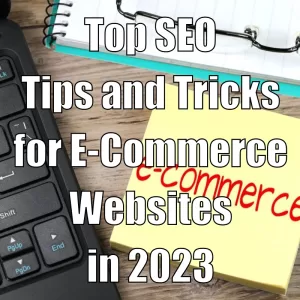 The e-commerce industry is thriving, and it is more important than ever for online stores to have effective SEO strategies to attract and retain customers. In 2023, search engine optimization will continue to be a key factor in the success of e-commerce websites. In this article, we will share some top SEO tips and tricks that e-commerce website owners can implement to improve their website’s ranking, increase visibility, and drive more traffic and sales.
The e-commerce industry is thriving, and it is more important than ever for online stores to have effective SEO strategies to attract and retain customers. In 2023, search engine optimization will continue to be a key factor in the success of e-commerce websites. In this article, we will share some top SEO tips and tricks that e-commerce website owners can implement to improve their website’s ranking, increase visibility, and drive more traffic and sales.
As always, if you have any other questions about Kelowna SEO or E-commerce SEO, please do not hesitate to contact us.
- Understanding E-commerce SEO
E-commerce SEO involves optimizing your online store’s pages to rank higher in search engine results pages (SERPs). The higher your website ranks, the more traffic and potential customers you can attract. E-commerce SEO differs from traditional SEO because online stores have different types of pages, such as product pages, category pages, and shopping cart pages. Effective e-commerce SEO requires a thorough understanding of how search engines crawl and index web pages, as well as an understanding of your target audience and their search behaviors. - Conducting Keyword Research
Keyword research is a crucial component of any SEO strategy. It involves identifying the keywords and phrases that your target audience is searching for and optimizing your website’s pages to rank for those terms. Start by using keyword research tools like Google Keyword Planner, SEMrush, or Ahrefs to identify relevant keywords with high search volumes and low competition. Use these keywords to optimize your product pages, category pages, and blog posts. Be sure to include long-tail keywords that are more specific and less competitive but still relevant to your products. - Optimizing Product Pages
Optimizing your product pages is one of the most important aspects of e-commerce SEO. Ensure that each product page has a unique and descriptive title tag and meta description that includes relevant keywords. Use high-quality images and videos to showcase your products, and include detailed product descriptions with bullet points. Be sure to use unique product descriptions rather than copy-pasting manufacturer descriptions to avoid duplicate content issues. - Creating Compelling Content
Creating compelling content is crucial for attracting and retaining customers. Use your blog to create informative and engaging content that appeals to your target audience. Ensure that your content is optimized for search engines by including relevant keywords, internal linking to product and category pages, and formatting your content with H1, H2, and H3 headings. Use infographics, videos, and other visual elements to make your content more engaging and shareable. - Implementing Structured Data Markup
Structured data markup helps search engines better understand the content and structure of your website. Use schema markup to highlight key information about your products, such as price, availability, and reviews. This will make your website more visible in search results and improve click-through rates. - Building High-Quality Backlinks
Backlinks are an important ranking factor for search engines. Focus on building high-quality backlinks from reputable websites in your industry. Reach out to other bloggers and website owners and offer to exchange links or guest post on their websites. Be sure to avoid spammy link building practices, such as buying links or participating in link farms, as these can hurt your website’s ranking. - Optimizing for Mobile Devices
With more and more people accessing the internet on their mobile devices, it’s essential to have a mobile-friendly website. Ensure that your website is responsive and loads quickly on all devices. Use Google’s mobile-friendly test to check if your website is optimized for mobile devices. Make sure that your website’s buttons and calls-to-action are easy to click and that your website’s navigation is intuitive on smaller screens.
- Improving Page Speed
Page speed is another crucial factor for both search engine ranking and user experience. Use tools like Google’s PageSpeed Insights or GTmetrix to analyze your website’s load time and identify areas for improvement. Some tips for improving page speed include optimizing images, minimizing HTTP requests, and reducing file sizes. - Utilizing Social Media
Social media can be a powerful tool for e-commerce SEO. Use social media platforms like Facebook, Twitter, and Instagram to promote your products and drive traffic to your website. Share your blog content on social media, and engage with your followers by responding to comments and messages. Be sure to include social sharing buttons on your website to make it easy for visitors to share your content on their own social media profiles. - Monitoring and Analyzing Performance
Monitoring and analyzing your website’s performance is crucial for understanding the effectiveness of your SEO strategy. Use tools like Google Analytics or SEMrush to track your website’s traffic, keyword rankings, and backlinks. Analyze your website’s performance regularly, and make adjustments to your SEO strategy as needed. - Keeping Up with Industry Trends
The world of SEO is constantly changing, and it’s essential to keep up with the latest trends and best practices. Follow industry blogs and attend SEO conferences and webinars to stay up-to-date on the latest trends in e-commerce SEO. - Avoiding Common SEO Mistakes
Avoiding common SEO mistakes can help improve your website’s ranking and traffic. Some common SEO mistakes to avoid include keyword stuffing, duplicate content, and using irrelevant or misleading titles and meta descriptions. - Measuring Success
Measuring the success of your SEO strategy is crucial for understanding the return on investment (ROI) of your efforts. Set goals for your website’s traffic, conversion rates, and revenue, and track your progress over time. Use this data to make informed decisions about your SEO strategy and adjust your approach as needed.
- Improving Page Speed
Conclusion: Putting it all together
Effective SEO is a critical component of the success of e-commerce websites in 2023. By implementing the top SEO tips and tricks, e-commerce website owners can improve their website’s ranking, increase visibility, and drive more traffic and sales. Conducting thorough keyword research, optimizing product pages, creating compelling content, implementing structured data markup, building high-quality backlinks, optimizing for mobile devices, improving page speed, utilizing social media, monitoring and analyzing performance, keeping up with industry trends, avoiding common SEO mistakes, and measuring success are all essential elements of an effective SEO strategy for e-commerce websites.
With the increasing competition in the e-commerce industry, it is more important than ever to prioritize SEO and stay ahead of the game. By following these SEO tips and tricks, e-commerce website owners can increase their website’s visibility, attract more customers, and ultimately drive more sales. Therefore, it is crucial to prioritize SEO as a long-term investment for the success of your e-commerce business in 2023 and beyond.
Let’s Work Together
TELL US MORE ABOUT YOUR PROJECT
Let us help you get your website found. Or, if you simply have a few questions, then fill out the form below and we will get back to you.

